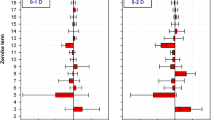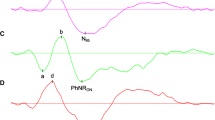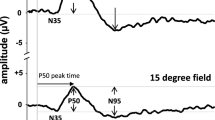Abstract
In studies on the pattern electroretinogram the quality of the retinal image is a major concern. The use of contact lens electrodes was rejected since a good pattern could not be recorded. This is believed to be due to blurring of the retinal image. As indicator of image quality the patient's visual acuity is often used. We wondered whether this is a sufficient criterion. The retinal image is the product of the whole optical point-spread function of the eye whereas visual acuity refers only to the central portion of this function. On the basis of existing reports it can be estimated that for the young normal eye the outer edges of this function (straylight) causes considerable loss of contrast. The strength of the straylight can be much greater in older eyes. We studied the relation between the point-spread function including straylight and the pattern electroretinogram in normal eyes and some pathological cases. The measurements proved to follow the calculated contrasts on the basis of a local luminance model, with the exception of enhancement (tuning) around 60′ checksize for the young normal eye. Because of the considerable differences in straylight in an older population one has to take into account that loss of pattern electroretinogram can be suffered in patients with otherwise good visual acuity.
Similar content being viewed by others
References
Arden GB, Vaegan. Electroretinograms evoked in man by local uniform or patterned stimulation. J Physiol 1983; 341: 85–104.
Berg TJTP van den. Importance of pathological intraocular light scatter for visual disability. Doc Ophthalmol 1986; 61: 327–333.
Cambell FW, Gubisch RW. Optical quality of the human eye. J Physiol Lond 1966; 186: 558–578.
Dagnelie G. Pattern and motion processing in primate visual cortex. Thesis, University of Amsterdam, 1986.
Dawson WW, Trick GL, Litzkow CA. Improved electode for electroretinography. Invest Ophthalmol Vis Sci 1979; 18: 988–991.
Holladay LL. Action of a lightsource in the field of view in lowering visibility. J Opt Soc Am 1927; 14: 1–15.
Riemslag FCC, Ringo JL, Spekreijse H, Verduyn Lunel HF. The luminance origin of the pattern electroretinogram in man. J Physiol 1985; 363: 191–209.
Spekreijse H, Estévez O, Tweell LH van der. Luminance responses to pattern reversal. Doc Ophthalmol Proc Ser ISCERG Symp, Los Angeles 1972, 1973; 205–211.
Spekreijse H, Dagnelie G Maier J, Regan D. Flicker and movement constituents of the pattern-reversal response. Vis Res 1985; 25: 1297–1304.
Stiles WS, Crawford BH. The effect of a glazing light source on extrafoveal vision. Proc Roy Soc London 1937; 122B: 255–280.
Vos JJ. Verblinding bij tunnelingangen. I. De involved van strootilicht in het oog. Rapp IZF 1873 C-8 TNO, with English abstract, 1983.
Vos JJ, Walraven J, Meeteren A van. Light profiles of the foveal image of a point source. Vis Res 1976; 16: 215–219.
Author information
Authors and Affiliations
Rights and permissions
About this article
Cite this article
Van Den Berg, T.J.T.P., Boltjes, B. The point-spread function of the eye from 0° to 100° and the pattern electroretinogram. Doc Ophthalmol 67, 347–354 (1987). https://doi.org/10.1007/BF00143952
Issue Date:
DOI: https://doi.org/10.1007/BF00143952




